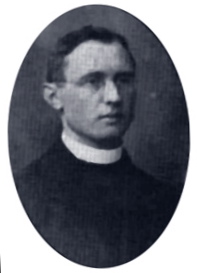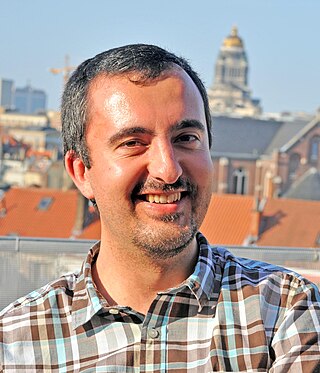
Anthropology is the scientific study of humanity, concerned with human behavior, human biology, cultures, societies, and linguistics, in both the present and past, including past human species. Social anthropology studies patterns of behavior, while cultural anthropology studies cultural meaning, including norms and values. A portmanteau term sociocultural anthropology is commonly used today. Linguistic anthropology studies how language influences social life. Biological or physical anthropology studies the biological development of humans.
Dell Hathaway Hymes was a linguist, sociolinguist, anthropologist, and folklorist who established disciplinary foundations for the comparative, ethnographic study of language use. His research focused upon the languages of the Pacific Northwest. He was one of the first to call the fourth subfield of anthropology "linguistic anthropology" instead of "anthropological linguistics". The terminological shift draws attention to the field's grounding in anthropology rather than in what, by that time, had already become an autonomous discipline (linguistics). In 1972 Hymes founded the journal Language in Society and served as its editor for 22 years.

Ethnography is a branch of anthropology and the systematic study of individual cultures. Ethnography explores cultural phenomena from the point of view of the subject of the study. Ethnography is also a type of social research that involves examining the behavior of the participants in a given social situation and understanding the group members' own interpretation of such behavior.

Visual anthropology is a subfield of social anthropology that is concerned, in part, with the study and production of ethnographic photography, film and, since the mid-1990s, new media. More recently it has been used by historians of science and visual culture. Although sometimes wrongly conflated with ethnographic film, visual anthropology encompasses much more, including the anthropological study of all visual representations such as dance and other kinds of performance, museums and archiving, all visual arts, and the production and reception of mass media. Histories and analyses of representations from many cultures are part of visual anthropology: research topics include sandpaintings, tattoos, sculptures and reliefs, cave paintings, scrimshaw, jewelry, hieroglyphics, paintings and photographs. Also within the province of the subfield are studies of human vision, properties of media, the relationship of visual form and function, and applied, collaborative uses of visual representations.

Anne MacKaye Chapman was a Franco-American ethnologist who focused on the people of Mesoamerica writing several books, co-producing movies, and capturing sound recordings of rare languages from the Northern Triangle of Central America to Cape Horn in South America.
The USC Center for Visual Anthropology (CVA) is a center located at the University of Southern California. It is dedicated to the field of visual anthropology, incorporating visual modes of expression in the academic discipline of anthropology. It does so in conjunction with faculty in the anthropology department through five types of activities: training, research and analysis of visual culture, production of visual projects, archiving and collecting, and the sponsorship of conferences and film festivals. It offers a B.A. and an MVA in Visual Anthropology.
Daniel Miller is an anthropologist who is closely associated with studies of human relationships to things, the consequences of consumption and digital anthropology. His theoretical work was first developed in Material Culture and Mass Consumption and is summarised more recently in his book Stuff. This is concerned to transcend the usual dualism between subject and object and to study how social relations are created through consumption as an activity.

Video ethnography is the video recording of the stream of activity of subjects in their natural setting, in order to experience, interpret, and represent culture and society. Ethnographic video, in contrast to ethnographic film, cannot be used independently of other ethnographic methods, but rather as part of the process of creation and representation of societal, cultural, and individual knowledge. It is commonly used in the fields of visual anthropology, visual sociology, and cultural studies. Uses of video in ethnography include the recording of certain processes and activities, visual note-taking, and ethnographic diary-keeping.

Father Sebastian Englert OFM Cap., was a Capuchin Franciscan friar, Roman Catholic priest, missionary, linguist and ethnologist from Germany. He is known for his pioneering work on Easter Island, where the Father Sebastian Englert Anthropological Museum is named after him.
Ethnofiction refers to a subfield of ethnography which produces works that introduce art, in the form of storytelling, "thick descriptions and conversational narratives", and even first-person autobiographical accounts, into peer-reviewed academic works.

An ethnographic film is a non-fiction film, often similar to a documentary film, historically shot by Western filmmakers and dealing with non-Western people, and sometimes associated with anthropology. Definitions of the term are not definitive. Some academics claim it is more documentary, less anthropology, while others think it rests somewhere between the fields of anthropology and documentary films.
Elizabeth A. Povinelli is Franz Boas Professor of Anthropology and Gender Studies at Columbia University, where she has also been the Director of the Institute for Research on Women and Gender and the Co-Director of the Centre for the Study of Law and Culture. She received her Ph.D. in Anthropology from Yale University in 1991. She is the author of books and essays of critical theory as well as a former editor of the academic journal Public Culture.

Martín Gusinde was an Austrian priest and ethnologist famous for his work in anthropology, particularly on the native groups of Tierra del Fuego. He was one of the most notable anthropologists in Chile in the first half of the 20th century, together with Max Uhle and Aureliano Oyarzún Navarro.

The Martin Gusinde Anthropological Museum is an anthropology museum in Puerto Williams, Isla Navarino, in southernmost Chile. It is the southernmost museum of the world. The museum hosts artifacts, maps and photographs related to the 10,000-year history of the Yahgan people, as well as European settlers since the 19th century. Samples of local flora and fauna are also displayed, as well as photographs and text from the founding of Puerto Williams.

Noel B. Salazar is a sociocultural anthropologist known for his transdisciplinary work on mobility and travel, the local-to-global nexus, discourses and imaginaries of 'Otherness', heritage, cultural brokering, cosmopolitanism and endurance.
Åke W. Sjöberg was a leading Assyriologist, specialized in Sumerian language and literature.
Veronica Strang is an author and professor of anthropology affiliated to Oxford University. Her work combines cultural anthropology with environmental studies, and focuses on the relationship between human communities and their environments. Strang's publications include the books 'The Meaning of Water' ; Gardening the World: agency, identity, and the ownership of water' ; 'What Anthropologists Do', 'Water Nature and Culture' and most recently 'Water Beings: from nature worship to the environmental crisis', which is based on a major comparative study of water deities around the world. Further information is available on her website at: https://www.veronicastrang.com/
Teresa Montoya is a Diné media maker and social scientist with training in socio-cultural anthropology, critical Indigenous studies, and filmmaking.
Sarah Pink is a British-born social scientist, ethnographer and social anthropologist, now based in Australia, known for her work using visual research methods such as photography, images, video and other media for ethnographic research in digital media and new technologies. She has an international reputation for her work in visual ethnography and her book Doing Visual Ethnography, first published in 2001 and now in its 4th edition, is used in anthropology, sociology, cultural studies, photographic studies and media studies. She has designed or undertaken ethnographic research in UK, Spain, Australia, Sweden, Brazil and Indonesia.

The Antarctic gateway cities are five cities on the rim of the Southern Ocean through which nearly all cargo and personnel bound for Antarctica pass. From west to east, they are Punta Arenas, Chile; Ushuaia, Argentina; Cape Town, South Africa; Hobart, Australia; and Christchurch, New Zealand. As Antarctica is a low-resource environment with no major transportation infrastructure of its own, gateway cities are a necessary part of all Antarctic activities.







